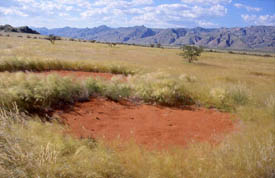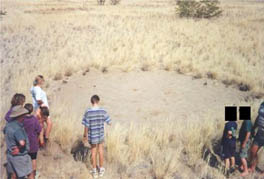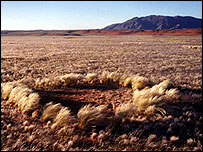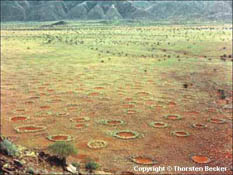
Namibia, Kaokoland Photo: Thorstein Becker

Namibia, Kaokoland Photo: Thorstein Becker

Pro-Namib region - "Fairy Circle".
Photo: news.bbc.co.uk.
Click for larger images.

Namibia, Kaokoland Photo: Th. Becker
NAMIBIA, western coast desert
naked circular areas in desert sand
South African botanists say they have failed to explain the mysterious round patches of bare sandy soil
found in grassland on Namibia's coastal fringe.
They looked into possible causes of the "fairy circles" - radioactive soil, toxic proteins left by poisonous plants,
and termites eating the seeds. But tests do not support any of these theories for the rings which are 2-10m across,
New Scientist magazine reports. For now, the botanists are left with "fairies" to explain the phenomenon. Termite
trenches Lead scientist Gretel van Rooyen is exploring the theory that, somehow, toxic elements are deposited in
the shape of the circle, making it impossible for plant life to get established there. "But even if we find them, how
they came there is the next problem - for the moment, we're left with the fairies," Ms van Rooyen, from University
of Pretoria, said. Tests of soil samples taken from the circles found all to be negative for radioactivity and desert
plants were successfully cultivated in the lab on soil which had previously supported poisonous milk bushes
(Euphorbia damarana). As for the termites, the team dug trenches up to 2m deep in and around the circles, but
found no sign of these insects or their nests.
Fairy circles occur in a broken belt in the pro-Namib region, from southern Angola to the Orange River in South Africa
and have become so famous that they are included in visitors' tours.